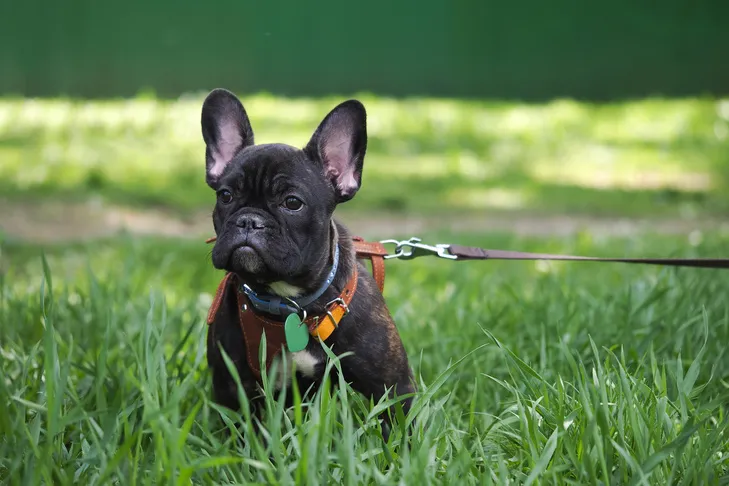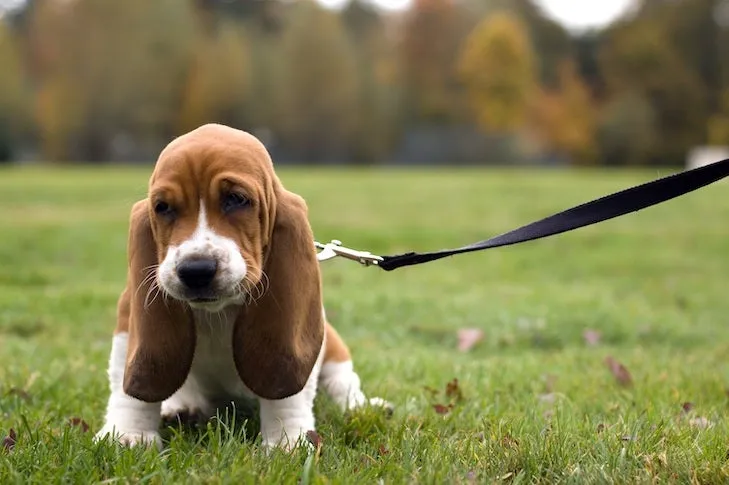Leash training is a fundamental skill for any dog, crucial for safe and enjoyable walks in any environment. While many believe puppies instinctively know how to walk politely on a leash, this is a learned behavior that requires patient and consistent training. Establishing good leash manners early on sets the stage for a well-behaved adult dog, enhancing both your and your puppy’s quality of life. Dog training expert and AKC Family Dog columnist Kathy Santo emphasizes the importance of a solid foundation to ensure future walks are pleasant experiences.
Beginning leash training early is highly beneficial. Generally, puppies can start getting accustomed to a collar and leash as young as 8 weeks old, once they’ve settled into their new home and are comfortable. The key is to make these early experiences positive and stress-free. Introducing these tools gently and associating them with positive reinforcement, such as treats and playtime, will help your puppy develop a positive association with walking on a leash. This early exposure helps them view the leash not as a restriction but as a signal for fun and adventure.
Laying the Foundation: Early Leash Training Steps
A successful leash training journey starts with a series of simple, positive steps designed to build your puppy’s confidence and understanding.
Introduction to Collar, Harness, and Leash
Start by simply letting your puppy wear a lightweight collar or a comfortable harness for short periods inside the house. The goal is for them to associate these items with pleasant experiences. Put the collar or harness on just before playtime or mealtime, offering treats and praise. Supervise them closely, and remove it after a few minutes, gradually increasing the wear time as they get comfortable. The leash can be attached and dragged around the house (under supervision) once they are completely at ease with the collar or harness, ensuring they love this “collar-and-leash time” as it signals food and fun.
Teaching a “Food is Coming” Cue
A distinct sound cue is invaluable for capturing your puppy’s attention. This could be a clicker, a specific word like “yes,” or a tongue cluck. In a quiet, distraction-free space, with your puppy wearing their collar and leash, make your chosen sound. The instant your puppy acknowledges the sound by turning or looking at you, immediately reward them with a small, high-value treat. Repeat this many times. Soon, your puppy will not only look at you but also start moving towards you, anticipating the reward. This teaches them to focus on you, which is critical for successful leash training.
Encouraging Your Puppy to Come to You
Once your puppy understands the “food is coming” cue, it’s time to incorporate movement. While they are on their way to you, still wearing the leash and collar, take a few steps backward. As they reach you, reward them. Continuously build on this, encouraging your puppy to follow you for several paces upon hearing the cue. Remember that puppies have very short attention spans. Keep your training sessions brief—ideally 5-10 minutes—and always end on a high note, leaving your puppy eager for the next session rather than feeling overwhelmed or fatigued. For pups that struggle with being independent, understanding how to get puppy out of crate can also help build their confidence in new situations.
Practicing Leash Walking Indoors
With a solid foundation established, practice walking a few steps in a quiet room with minimal distractions. For a puppy, simply feeling the leash and collar will be enough of a challenge initially. Continue to use your cue and offer plenty of treats and verbal praise as they learn to walk alongside you. This controlled environment allows them to grasp the mechanics of walking with a leash without the overwhelming stimuli of the outside world. Consistency in these indoor sessions is key to building good habits before transitioning to more stimulating environments. If you are struggling with establishing routines, guidance on how to train a stubborn dog to potty outside may also offer beneficial insights into consistent training methods.
Venturing Outside
When your puppy is confidently walking on a leash indoors, you’re ready to introduce them to the great outdoors. This step presents new challenges due to the myriad of new sights, sounds, and smells. Be patient, and keep the first outdoor walks very short to avoid overwhelming your puppy. During the walk, stay vigilant. If you notice your puppy is about to lunge towards something or become overly distracted, immediately use your cue sound and take a few steps away. Reward them with a treat for refocusing on you and following your lead. Gradually increase the duration and distance of your walks as your puppy becomes more accustomed to their surroundings.
 French bulldog puppy in a harness sitting in tall green grass on a leash for a walk.
French bulldog puppy in a harness sitting in tall green grass on a leash for a walk.
Troubleshooting Common Leash Training Challenges
Even with the best early training, puppies may encounter challenges as they grow, explore new places, and face more distractions. Addressing these issues proactively helps foster a positive walking experience and ensures your dog can master loose-leash walking, a vital skill for both of you. The AKC GoodDog! Helpline offers valuable tips for navigating these common hurdles.
When Your Puppy Pulls on the Leash
If your puppy starts to pull aggressively in a different direction, immediately stop and become “a tree.” Stand perfectly still and refuse to move forward until your dog relaxes the leash and returns their attention to you. Avoid yanking or jerking the leash, as this can be detrimental to your training efforts and potentially harm your dog. Alternative training tools like front-hook harnesses and head halters can be effective for dogs prone to pulling, helping to redirect their attention without causing discomfort. Addressing why my dog keeps breaking out of his crate might also offer solutions if your puppy’s behavior is rooted in frustration or lack of proper containment.
Addressing Puppy Lunging
When your dog fixates on something and attempts to lunge—be it another dog, a vehicle, or a skateboarder—proactive intervention is key. Observe your puppy closely and anticipate when they might lunge. Before they have a chance to react, use your cue to redirect their attention with a treat. Increase the distance between your puppy and the trigger, creating a comfortable buffer zone. Remaining alert and prepared can prevent the situation from escalating. While common in herding breeds, any dog can be startled or overexcited by new stimuli.
Managing Puppy Barking on Walks
Excessive barking at other dogs during walks can sometimes stem from insufficient mental and physical exercise. Ensure your puppy receives appropriate stimulation for their age and breed. If barking persists, employ the same redirection strategy used for lunging: create distance from the trigger and offer treats before the barking begins. This teaches your puppy to associate the presence of other dogs with positive rewards and encourages them to turn their attention to you instead of barking. Over time, they will learn to calmly observe other dogs.
 Basset Hound puppy sitting in the grass on lead.
Basset Hound puppy sitting in the grass on lead.
Conclusion
Leash training your puppy is an ongoing process that requires patience, consistency, and positive reinforcement. By starting early and following these foundational steps, you can cultivate excellent leash manners and build a strong bond with your furry companion. Gradually, you’ll find yourself relying less on treats and troubleshooting, enjoying harmonious walks together. Always keep some treats on hand for random reinforcement of good behavior, ensuring your puppy continues to associate leash walks with positive experiences. For further personalized advice and support, resources like the AKC GoodDog! Helpline connect you with professional trainers who can offer guidance on all aspects of puppy training and behavior.
